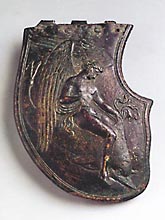Although the term 'metalwork' embraces all objects made in metal, large statues in bronze are usually dealt with under sculpture. For small objects, the usual term is toreutic or toreumata: this comprises small-scale objects whether in some alloy of copper (usually bronze) or in precious metal. It comprises small-scale plastic art - statuettes (chiefly for dedication at a temple), metal vessels and utensils, jewelry, and coins. In certain cases armour, when ornamental, is best classified as toreutic. These skills were often the province of the same coppersmiths or sculptors that made the large-scale statues. Calamis, Myron and Phidias are named by our ancient sources as toreuts who made metal vessels and did their own goldsmithing for their gold-and-ivory statues. Next to the Parthenon there was a building called the Chalkotheke. This was where metalwork dedications to Athena were stored. From the treasure-lists from the Parthenon and the Erechtheum we can see how many of these dedicatory pieces there were, and how varied and luxurious they were. The techniques used n making toreumata were casting and hammering; decoration was normally engraved or in high relief.
|
 |




